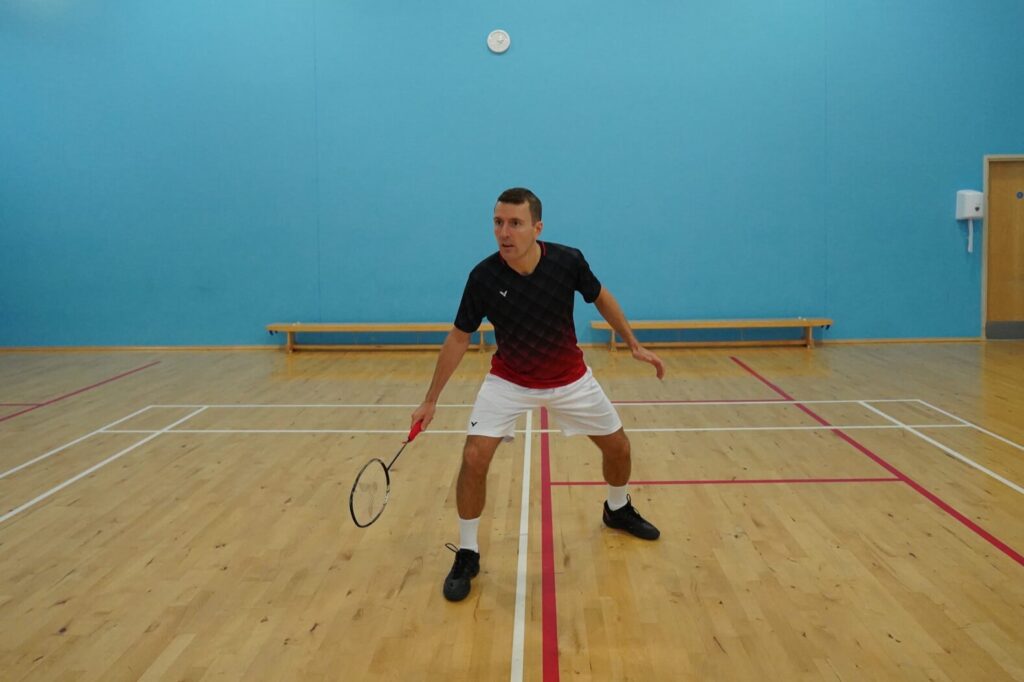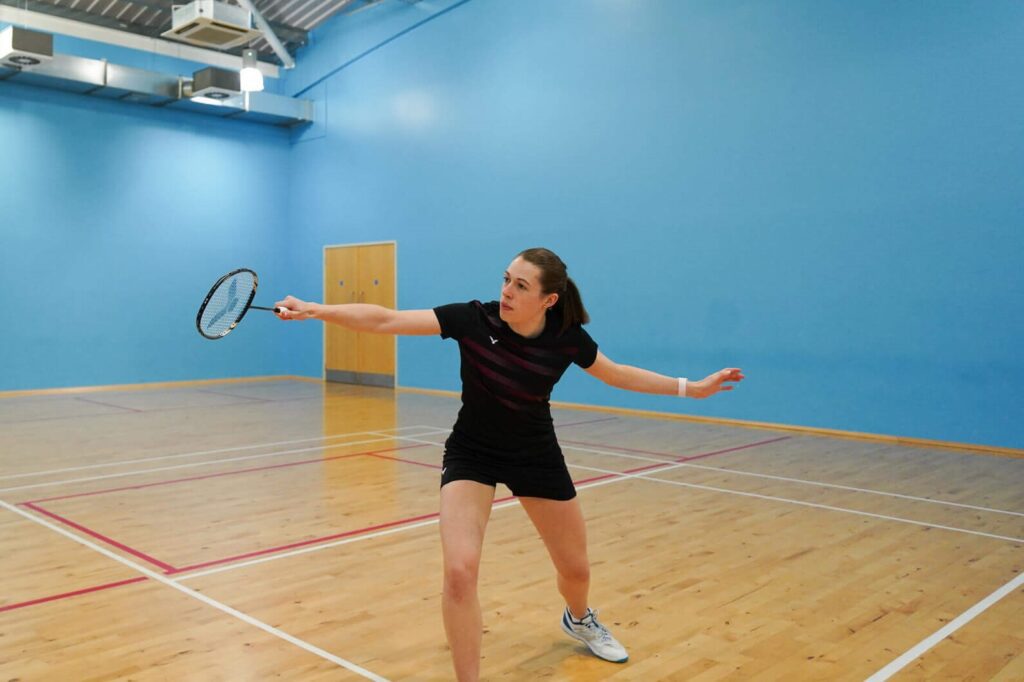5 Ways To Improve Your Footwork Speed In Badminton
Footwork in badminton is one of the hardest things to master, especially if you’ve developed bad habits over the years.
Having the right footwork not only helps you to be faster around the court but it also helps your efficiency which means you don’t get tired as easily!
5 ways to improve the speed and efficiency of your footwork are:
- Get your split step right
- Take slightly bigger steps
- Get the right timing of your lunge
- Have smooth footwork
- Develop your anticipation skills
There are lots of important points and tips for each of these, which we’ll now go through in more detail!
#1 - Get Your Split Step Right
The split step is the start of nearly every movement you do on the court, so it’s super important to get this step right! To improve your split step we have 3 main points:
1) Have A Low Centre Of Gravity
A mistake we often see is people standing with their legs either too straight or too narrow whilst waiting to split step. Having your legs too narrow makes it difficult to generate any power or explosive energy and having your legs too straight means that your centre of gravity isn’t low enough.
Instead, you want to have a low centre of gravity. This helps your balance and stability, enabling you to change direction faster.
This is why Formula 1 cars are so low to the ground – they are able to change direction at high speeds a lot better than a bus for example!
You should have your legs slightly bent and your feet slightly wider than shoulder width apart, like this:

2) Avoid Jumping In Your Split Step
Jumping when you do your split step wastes a lot of time!
So instead of jumping up, as your opponent is about to hit their shot, you should quickly drop down and slightly widen your feet as you land so you’re ready to push off out of this step as soon as you see where your opponent has hit their shot.
3) Split Step in the correct Direction
For this, we are talking about using directional split steps, which we’ll actually discuss in detail in point 4!
If you’re interested, you can learn more about how to perform the split step in badminton here.
#2 - Take Slightly Bigger Steps
This is a subtle change but taking slightly bigger steps on each movement can make a huge difference when you’re adding up all the time you save with every shot you play in the rally! With this saved time, you can reach the shuttle much earlier and have more options of what shots you can play.
To take bigger steps, you need to use the power in both of your legs, as opposed to letting your non-racket leg completely relax behind (which is what a lot of people do wrong).
It will of course take time to get used to, but practicing your footwork with the intention of taking slightly bigger steps and also developing strength in your non-racket leg to withstand this new demand will help a lot!
If you’re looking for ways to improve your on-court strength, check out our Badminton Specific Weights Programmes below:
#3 - Get The Right Timing Of Your Lunge
When lunging in the mid or front court, you should land your front foot just before you strike the shuttle (we’re talking milliseconds here), as this gives you control over your body and racket to play better quality shots and have a more efficient & faster recovery too.

Landing too early on your lunge in the mid or front court can have negative impacts on your footwork speed because:
- If you land before you’ve hit the shuttle, you’re unlikely to be in the exact position you want to be in, so you then need to lean to reach the shuttle and will be off balance.
- Being off balance will affect the quality of your shot, and also your speed of recovery as you need to re-gain balance before pushing off.
However, landing too late will also negatively impact your footwork speed because:
- This means you will have to strike the shuttle whilst your lunging foot is in the air, and you’ll have reduced control over your body and racket.
- This impacts your shot quality, and also means you still have to land and push off to retrieve the next shot, giving you much less time!
💡 To know if you're landing at the right or wrong time, you can film yourself playing and slow the clips down when you're lunging.
#4 - Have Smooth Footwork
Have you ever watched players that just look like they’re gliding around the court effortlessly, getting to each shot in perfect time? We have that feeling when we watch players like Lin Dan or Lee Chong Wei!
So, how can you get your footwork to be as smooth as theirs?
1) Adjust the speed of your recovery so that you never fully stop moving
You shouldn’t hit your shot, rush to recover and then completely stop as you lose your speed and momentum which makes you much less efficient. You want to flow around the court and carry the momentum from one movement to the next, which is what will make your movement a lot smoother!
2) Use directional split steps
You shouldn’t only be split stepping sideways, but should be doing directional split steps too, depending on the direction you’re going in.
For example, if you’re in the middle of the court and moving to your forehand forecourt corner you would split step like this to make your next steps both easier and faster:

But which way should you do this directional split step?
The direction in which you split your feet (either racket foot in front or non-racket foot in front), determines which way you think you’ll be moving. To learn more about the directional split step alongside some practices you can do to improve it, click here.
How can you practice having smooth footwork in badminton?
Doing shadow movements might seem boring but they are great for 2 reasons:
- You can learn new movements as you can slow them down completely without having to think about the shuttle.
- You can practice improving your footwork speed, again without having to think about the shuttle.
As you practice the movements you regularly do on-court more, they will become ingrained into your muscle memory, allowing you to perform them in a match without needing to think about it!
We’d recommend starting with short sets e.g. 10 shots, and do 10 rounds of this. Doing this just a couple of times a week will definitely help you make the footwork changes & improvements, and it only takes 5-10 minutes to do! You could even add it into the end of your warm up routine.
Another way to practice your footwork is by doing multi-feed. This is because the pace of the feeding can be altered to enable you to really focus on the footwork whilst still hitting shuttles!
#5 - Develop Your Anticipation Skills
Being able to correctly predict where the shuttle is going will hugely help your footwork. To improve your anticipation you need to do two things:
- Look at your opponent’s body positioning – are they in a good position and likely to play an attacking shot? Or are they defensive and taking it late, meaning the shuttle is likely to travel in an upwards direction?
- See where your opponent’s racket is facing – for example, is their racket head fixed and moving in a straight line across their body, potentially indicating a cross-court shot?
💡 Understanding your opponent’s body and racket positioning is key in being able to anticipate where the shuttle is going, so you can adjust your positioning to be faster onto the shot.

Another example in doubles is that you might notice your opponent hitting the shuttle just below the height of the net with a straight arm and a short swing which indicates they might play to the net. You can then move forwards and therefore play a much better shot than if you had waited for your opponent to hit the shot before moving.
💡 Bonus Tip: Playing shots that limit the options of what your opponent can play really helps you anticipate the shot. This is because you are almost eliminating certain areas of the court that you might need to move to - and this is what the best players do really well!
Learn More
As with anything, improving your footwork takes time and practice! But we hope you’re able to take away a few key points to work on, so that you’re able to think less about your footwork and more on actually playing the shot!
If you want to learn more about the footwork to move to each of the 4-corners in badminton, check out this video here.
Or, for more visual demonstrations of all the points we’ve discussed above as well as practices you can do to improve them, check out the full YouTube video below!

